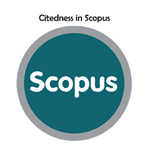SKRINING FITOKIMIA DAN UJI DAYA HAMBAT EKTRAK DAUN JAHE MERAH (Zingiber officinale var rubrum) TERHADAP BAKTERI Staphylococcus Epidermidis DAN Escherichia Coli
Abstract
Keywords
Full Text:
PDFReferences
Ali, B., Al-Wabel, N.A., Shams, S., Ahamad, A., Khan, S.A. and Anwar, F., 2015. Essential Oils Used in Aromatherapy: A Systemic Review. Asian Pacific Journal of Tropical Biomedicine. 5, Pp.601-611
Arna Ningsih dan Arsyik Ibrahim. 2013. Aktifitas antimikroba ekstrak fraksi n-heksan daun sungkai (peronema canescens. Jack) terhadap beberapa bakteri dengan metode klt-bioautografi. Universitas mulawarman: samarinda
Aziz Syaikhul., 2010, Uji Aktivitas Antibakteri Ekstrak Etanol Daun dan Umbi Bakung Putih (Crinum asiaticum L.) Terhadap Bakteri Penyebab Jerawat,Skripsi, Fakultas Kedokteran dan Ilmu Kesehatan Universitas IslamNegeri Syarif Hidayatullah, Jakarta
Brooks, G. F., Carroll, K. C., Butel, J. S., Morse, S. A., Mietzner, T. 2013. Jawetz, Melnick, & Adelberg's Medical Microbiology, 26th Edition. McGraw-Hill: New York
Kamazeri, T.S., Samah, O.A., Taher, M., Susanti, D. and Qaralleh, H. 2012. Antimicrobial Activity and Essential Oils of Curcuma aeruginosa, Curcuma mangga , and Zingiber cassumunar from Malaysia. Asian Pacific Journal of Tropical Medicine , 5, Pp.202-209.
Kholipatus syuhada. 2017. Evaluasi penambahan ekstrak daun jahe merah (zingiber officinale var. Rubrum) terhadap aktivitas antioksidan, total bakteri, ph, dan sifat organoleptik susu pasteurisasi komersial. Universitas dipenogoro : semarang
Harbone, J.B., Phytochemical Methods, diterjemahkan oleh Kosasi Padmawinata dan Iwang Soedio. 1987. Metode Fitokimia: Penuntun Cara Modern Menganalisis Tumbuhan. Penerbit ITB : Bandung.
Lay, B. W. and Hastowo. 1992. Mikrobiologi. Jakarta: Rajawali Press
Mesomo, M.C., Corazza, M.L., Ndiaye, P.M., Dalla Santa, O.R., Cardozo, L. And Scheer, A.P. 2013. Supercritical CO2Extracts and Essential Oil of Ginger (Zingiber officinale R.): Chemical Composition and Antibacterial
Mojab, F., Kamalinejad, M., Ghadeni, N., dan Vahidipour, H. R. 2003. Phytocemical Screening of Some Species of Iranian Plants.Iranian Journal of Pharmaceutical Research.
Pratiwi, Sylvia T. 2008. Mikrobiologi Farmasi. Jakarta: Erlangga.
Putri, R.R., R.F. Hakim, dan S. Rezeki. 2017. Pengaruh Ekstrak Daun Tapak Dara (Catharanthus roseus) terhadap Jumlah Fibroblas pada Proses Penyembuhan Luka di Mukosa Oral. Journal Caninus Denstistry
Ratna Djamil, Dkk. 2014, Identifikasi Senyawa Flavonoid Ekstrak Metanol Herba Jombang, Taraxacum Officinale Wiggers. ( ASTERACEAE) Secara Spektrofotometri Ultraviolet-Visibel. Fakultas Farmasi Universitas Pancasila : Jakarta
Shandar, H.K., B. Kumar, S. Prasher, P. Tiwari, M. Salhan, & P. Sharma. 2011. A Review Of Phytochemistry And Pharmacology Of Flavonoids. Internationale Pharmaceutica Sciencia, Vol. 1
Sarma, D. S. K & Babu, A. V. S. 2011. Antioxidant and Antimicrobial Activity of Ocimum americanum. PHARMANEST - An International Journal of Advances In Pharmaceutical Sciences Vol.2. ISSN 0976 -3090
Sivasothy, Y., Chong, W.K., Hamid, A., Eldeen, I.M., Sulaiman, S.F. and Awang, K. 2011. Essential Oils of Zingiber officinale var. Rubrum Theilade and Their Antibacterial Activities. Food Chemistry. 124, Pp. 514-517.
DOI: https://doi.org/10.37311/ijpe.v1i2.10547
Refbacks
- There are currently no refbacks.
Copyright (c) 2021 Annisa Humairah Ibrahim, Hamsidar Hasan, Mahdalena Sy. Pakaya

Indonesian Journal of Pharmaceutical Education is licensed under a Creative Commons Attribution-NonCommercial-ShareAlike 4.0 International License.



